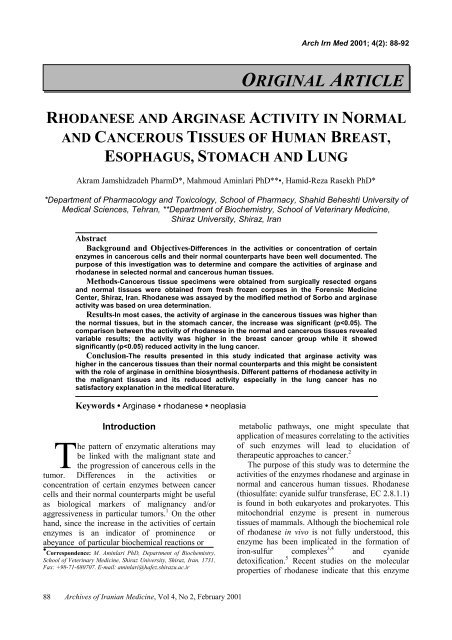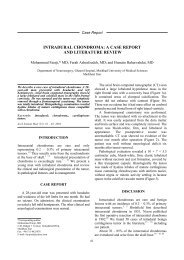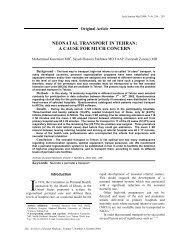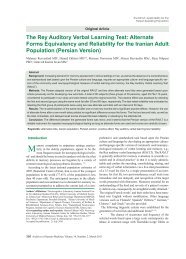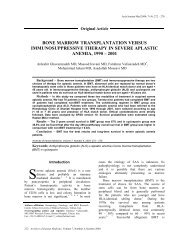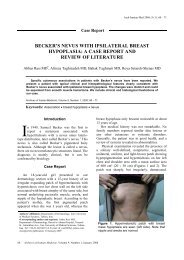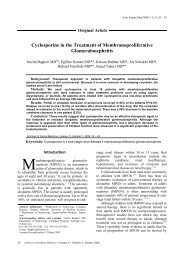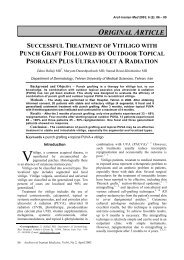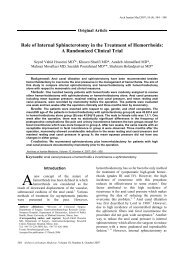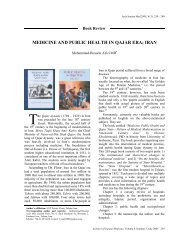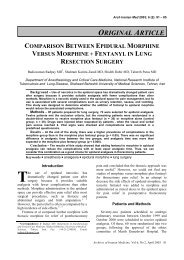rhodanese and arginase activity in normal and cancerous tissues of ...
rhodanese and arginase activity in normal and cancerous tissues of ...
rhodanese and arginase activity in normal and cancerous tissues of ...
Create successful ePaper yourself
Turn your PDF publications into a flip-book with our unique Google optimized e-Paper software.
88<br />
Archives <strong>of</strong> Iranian Medic<strong>in</strong>e, Vol 4, No 2, February 2001<br />
Arch Irn Med 2001; 4(2): 88-92<br />
RHODANESE AND ARGINASE ACTIVITY IN NORMAL<br />
AND CANCEROUS TISSUES OF HUMAN BREAST,<br />
ESOPHAGUS, STOMACH AND LUNG<br />
Akram Jamshidzadeh PharmD*, Mahmoud Am<strong>in</strong>lari PhD** , Hamid-Reza Rasekh PhD*<br />
*Department <strong>of</strong> Pharmacology <strong>and</strong> Toxicology, School <strong>of</strong> Pharmacy, Shahid Beheshti University <strong>of</strong><br />
Medical Sciences, Tehran, **Department <strong>of</strong> Biochemistry, School <strong>of</strong> Veter<strong>in</strong>ary Medic<strong>in</strong>e,<br />
Shiraz University, Shiraz, Iran<br />
Abstract<br />
Background <strong>and</strong> Objectives-Differences <strong>in</strong> the activities or concentration <strong>of</strong> certa<strong>in</strong><br />
enzymes <strong>in</strong> <strong>cancerous</strong> cells <strong>and</strong> their <strong>normal</strong> counterparts have been well documented. The<br />
purpose <strong>of</strong> this <strong>in</strong>vestigation was to determ<strong>in</strong>e <strong>and</strong> compare the activities <strong>of</strong> <strong>arg<strong>in</strong>ase</strong> <strong>and</strong><br />
<strong>rhodanese</strong> <strong>in</strong> selected <strong>normal</strong> <strong>and</strong> <strong>cancerous</strong> human <strong>tissues</strong>.<br />
Methods-Cancerous tissue specimens were obta<strong>in</strong>ed from surgically resected organs<br />
<strong>and</strong> <strong>normal</strong> <strong>tissues</strong> were obta<strong>in</strong>ed from fresh frozen corpses <strong>in</strong> the Forensic Medic<strong>in</strong>e<br />
Center, Shiraz, Iran. Rhodanese was assayed by the modified method <strong>of</strong> Sorbo <strong>and</strong> <strong>arg<strong>in</strong>ase</strong><br />
<strong>activity</strong> was based on urea determ<strong>in</strong>ation.<br />
Results-In most cases, the <strong>activity</strong> <strong>of</strong> <strong>arg<strong>in</strong>ase</strong> <strong>in</strong> the <strong>cancerous</strong> <strong>tissues</strong> was higher than<br />
the <strong>normal</strong> <strong>tissues</strong>, but <strong>in</strong> the stomach cancer, the <strong>in</strong>crease was significant (p
also plays an important metabolic function <strong>in</strong> the<br />
regulation <strong>of</strong> mitochondrial respiration rate. 6<br />
Furthermore, peculiar distribution <strong>of</strong> this<br />
enzyme <strong>in</strong> human 7 <strong>and</strong> animal <strong>tissues</strong> 8 suggests<br />
that cyanide metabolism is not the only, or even<br />
the major role <strong>of</strong> <strong>rhodanese</strong>. In particular, our<br />
study which <strong>in</strong>dicates high level <strong>of</strong> <strong>rhodanese</strong><br />
<strong>activity</strong> <strong>in</strong> the epithelial layer <strong>of</strong> certa<strong>in</strong> organs<br />
such as the gastro<strong>in</strong>test<strong>in</strong>al 9 <strong>and</strong> respiratory tracts 10<br />
as well as <strong>in</strong> the kidney cortex <strong>of</strong> animals 11 ,<br />
suggests that <strong>tissues</strong> hav<strong>in</strong>g raised turnover rate or<br />
those <strong>in</strong>volved <strong>in</strong> higher metabolic rate might<br />
conta<strong>in</strong> higher <strong>rhodanese</strong> activities than <strong>normal</strong><br />
<strong>tissues</strong>.<br />
Arg<strong>in</strong>ase (L-arg<strong>in</strong><strong>in</strong>e amid<strong>in</strong>ohydrolase, EC<br />
3.5.3.1), which catalyzes the hydrolysis <strong>of</strong> Larg<strong>in</strong><strong>in</strong>e<br />
<strong>in</strong>to L-ornith<strong>in</strong>e <strong>and</strong> urea, was first<br />
detected <strong>in</strong> mammalian livers as the term<strong>in</strong>al<br />
enzyme <strong>of</strong> the urea cycle. 12 Arg<strong>in</strong>ase <strong>activity</strong><br />
occurs also <strong>in</strong> other <strong>tissues</strong>, which are devoid <strong>of</strong> a<br />
complete urea cycle. 13-15 In the latter <strong>in</strong>stance, the<br />
importance <strong>of</strong> <strong>arg<strong>in</strong>ase</strong> may be <strong>in</strong> the production <strong>of</strong><br />
ornith<strong>in</strong>e for the synthesis <strong>of</strong> the polyam<strong>in</strong>es<br />
putresc<strong>in</strong>e <strong>and</strong> sperm<strong>in</strong>e, which are required for<br />
<strong>normal</strong> cellular proliferation. 16,17 Several reports<br />
<strong>in</strong>dicate that a higher <strong>activity</strong> <strong>of</strong> <strong>arg<strong>in</strong>ase</strong> is present<br />
<strong>in</strong> <strong>cancerous</strong> <strong>tissues</strong>. 18-21 The results obta<strong>in</strong>ed <strong>in</strong><br />
this study <strong>in</strong>dicate that <strong>in</strong> certa<strong>in</strong> tumors, the levels<br />
<strong>of</strong> <strong>activity</strong> <strong>of</strong> <strong>rhodanese</strong> or <strong>arg<strong>in</strong>ase</strong> are different<br />
from <strong>normal</strong> <strong>tissues</strong>.<br />
Materials <strong>and</strong> Methods<br />
All chemicals were <strong>of</strong> analytical grade <strong>and</strong> were<br />
supplied by commercial sources. Cancerous tissue<br />
specimens were obta<strong>in</strong>ed from the surgically<br />
resected organs <strong>of</strong> patients referred to the Iranian<br />
Cancer Institute. In order to assure adequate<br />
diagnostic evaluation <strong>of</strong> the tissue, each sample<br />
was divided <strong>in</strong>to two parts, one was sent for<br />
pathologie exam<strong>in</strong>ation <strong>and</strong> the other for<br />
biochemical assessment. The samples were<br />
analyzed on a bl<strong>in</strong>d basis such that the personnel<br />
perform<strong>in</strong>g biochemical or pathological studies<br />
were unaware <strong>of</strong> the results <strong>of</strong> the other study<br />
group till completion <strong>of</strong> the research. The <strong>normal</strong><br />
<strong>tissues</strong> were taken from fresh frozen corpses <strong>in</strong> the<br />
Forensic Medic<strong>in</strong>e Center, Shiraz with<strong>in</strong> 5-10<br />
hours after death. These <strong>tissues</strong> were proven to be<br />
<strong>normal</strong> by the Center’s pathologist. All <strong>normal</strong><br />
<strong>tissues</strong> were taken from 5 males <strong>and</strong> 4 females.<br />
Preparation <strong>of</strong> tissue extract<br />
All samples, kept on ice, were transferred<br />
A. Jamshidzadeh, M. Am<strong>in</strong>lari, H. R. Rasekh<br />
with<strong>in</strong> 45 m<strong>in</strong>utes to the laboratory; <strong>tissues</strong> were<br />
separated, stripped from adipose tissue, cleansed<br />
with physiological sal<strong>in</strong>e, <strong>and</strong> then bottled. Tissue<br />
extracts were prepared by freez<strong>in</strong>g the samples <strong>in</strong><br />
liquid nitrogen, homogeniz<strong>in</strong>g with a h<strong>and</strong><br />
homogenizer <strong>and</strong> suspend<strong>in</strong>g the homogenates <strong>in</strong><br />
0.025 M sodium phosphate buffer, pH 7.2. The<br />
suspensions were centrifuged for 15 m<strong>in</strong>utes at<br />
400g <strong>in</strong> a MSE high-speed refrigerated centrifuge.<br />
Supernatants were used as the enzyme source.<br />
Samples with high enzyme <strong>activity</strong> or high prote<strong>in</strong><br />
content were appropriately diluted with phosphate<br />
buffer <strong>and</strong> the f<strong>in</strong>al results were multiplied by the<br />
dilution factor.<br />
Determ<strong>in</strong>ation <strong>of</strong> <strong>rhodanese</strong> <strong>activity</strong><br />
Rhodanese was assayed by the modified<br />
method <strong>of</strong> Sorbo. 22 The reaction mixture conta<strong>in</strong>ed<br />
16.8 mMol/L sodium thiosulfate, 40 mMol/L<br />
glyc<strong>in</strong>e buffer, pH 9.2, 6.7 mMol/L KCN, <strong>and</strong> 30<br />
μL <strong>of</strong> enzyme solution <strong>in</strong> a f<strong>in</strong>al volume <strong>of</strong> 4 mL.<br />
The reaction was carried out for 20 m<strong>in</strong>utes at<br />
37˚C <strong>and</strong> stopped by add<strong>in</strong>g 0.5 mL 38%<br />
formaldehyde. In the control tubes formaldehyde<br />
was added prior to addition <strong>of</strong> enzyme solution.<br />
The concentration <strong>of</strong> thiocyanate was determ<strong>in</strong>ed<br />
as follows (Sorbo, 1953): samples were mixed with<br />
1 mL <strong>of</strong> ferric nitrate solution conta<strong>in</strong><strong>in</strong>g 0.025 g<br />
Fe (NO3)3, 9 H2O <strong>in</strong> 0.74 mL water <strong>and</strong> 0.26 mL<br />
concentrated nitric acid. After centrifug<strong>in</strong>g the<br />
mixture to remove the <strong>in</strong>terfer<strong>in</strong>g turbidity,<br />
absorbances were measured at 460 nm aga<strong>in</strong>st a<br />
blank which conta<strong>in</strong>ed all reagents except that 30<br />
μL water was substituted for the enzyme solution.<br />
The concentration <strong>of</strong> formed thiocyanate was<br />
obta<strong>in</strong>ed from a st<strong>and</strong>ard curve produced by<br />
treat<strong>in</strong>g solutions conta<strong>in</strong><strong>in</strong>g different<br />
concentrations <strong>of</strong> thiocyanate as described above.<br />
In this study, pH 9.2 was used <strong>in</strong>stead <strong>of</strong> pH 7.4<br />
(which is rout<strong>in</strong>ely used) <strong>in</strong> order to decrease the<br />
turbidity <strong>of</strong> solutions after addition <strong>of</strong> ferric nitrate.<br />
No significant differences were observed when<br />
purified <strong>rhodanese</strong> was assayed at pH 7.4 or 9.2.<br />
The unit <strong>of</strong> enzyme <strong>activity</strong> was def<strong>in</strong>ed as<br />
micromole thiocyanate formed per m<strong>in</strong>ute at 37˚ C<br />
<strong>and</strong> pH 9.2.<br />
Determ<strong>in</strong>ants <strong>of</strong> <strong>arg<strong>in</strong>ase</strong> <strong>activity</strong><br />
A 0.02 mL <strong>of</strong> tissue extract was mixed with 0.5<br />
mL sapon<strong>in</strong> solution <strong>and</strong> <strong>in</strong>cubated at 37˚ C for 10<br />
m<strong>in</strong>utes. About 0.02 mL <strong>of</strong> 10% MnCl2 was added<br />
<strong>and</strong> the mixture was <strong>in</strong>cubated for 10 m<strong>in</strong>utes<br />
followed by addition <strong>of</strong> 0.2 mL 0.02 mol/L<br />
Archives <strong>of</strong> Iranian Medic<strong>in</strong>e, Vol 4, No 2, February 2001 89
90<br />
A. Jamshidzadeh, M. Am<strong>in</strong>lari, H. R. Rasekh<br />
Table 1. General characteristics <strong>of</strong> patients <strong>in</strong>cluded <strong>in</strong> this study.<br />
Sex Grad<strong>in</strong>g<br />
Mean age Type<br />
Female Male Poor Mod Well<br />
Breast (n=6) 6 0 56±5.5 4 Infiltrative lobular CA, 2 <strong>in</strong>filtrative<br />
ductal CA<br />
Archives <strong>of</strong> Iranian Medic<strong>in</strong>e, Vol 4, No 1, January 2001<br />
4 1 1<br />
Esophagus (n=7) 3 4 54±11 All SCC except one adenocarc<strong>in</strong>oma 4 1 2<br />
Stomach (n=10) 6 4 54±9.4 All adenocarc<strong>in</strong>omas 5 3 2<br />
Lung (n=5) 2 3 59±10 All SCC except one adenocarc<strong>in</strong>oma 2 2 1<br />
Total (n=28) 17 11 55±9 --- 15 7 6<br />
SCC: squamous cell carc<strong>in</strong>oma, Poor: poorly differentiated, Mod: moderately differentiated, Well: well differentiated.<br />
arg<strong>in</strong><strong>in</strong>e solution. After mix<strong>in</strong>g <strong>and</strong> <strong>in</strong>cubat<strong>in</strong>g at<br />
37˚ C for 20 m<strong>in</strong>utes, one mL tungestic acid<br />
solution (equal parts <strong>of</strong> 2.2% sodium tungstate <strong>and</strong><br />
0.15 N sulfuric acid) <strong>and</strong> 0.26 mL 0.1 mol/L HCl<br />
was added <strong>and</strong> the mixture was further centrifuged.<br />
One mililiter <strong>of</strong> the supernatant was used for urea<br />
measurement. The amount <strong>of</strong> formed urea was<br />
determ<strong>in</strong>ed accord<strong>in</strong>g to the method described<br />
elsewhere. 23 About 2.5 mL <strong>of</strong> acid mix<br />
(phosphoric-sulfuric) <strong>and</strong> 0.5 mL 2%<br />
diacetylmonoxime was added to 1 mL aliquot <strong>of</strong><br />
the reaction mixture, which had been stopped with<br />
tungestic acid <strong>and</strong> HCl. This mixture was shaken<br />
vigorously <strong>and</strong> heated for 30 m<strong>in</strong>utes <strong>in</strong> a boil<strong>in</strong>g<br />
water bath. The absorbance was read aga<strong>in</strong>st a<br />
blank with a Bausch <strong>and</strong> Lomb Spec 20 (Arthur H.<br />
Thomas Co., Philadelphia, Pa) at a wavelength <strong>of</strong><br />
475 nm. One unit enzyme <strong>activity</strong> is the amount <strong>of</strong><br />
enzyme required to produce1 μmol urea per<br />
m<strong>in</strong>utes at 37˚ C.<br />
Prote<strong>in</strong> determ<strong>in</strong>ation<br />
Prote<strong>in</strong> content <strong>of</strong> tissue extracts was<br />
determ<strong>in</strong>ed by the method <strong>of</strong> Lowry et al. (1951) 24<br />
us<strong>in</strong>g crystall<strong>in</strong>e bov<strong>in</strong>e serum album<strong>in</strong> as<br />
st<strong>and</strong>ard.<br />
Statistical analysis<br />
The data were expressed as mean±SD <strong>and</strong><br />
<strong>normal</strong> <strong>tissues</strong> data were analyzed by one-way<br />
ANOVA by us<strong>in</strong>g SPSS/PC s<strong>of</strong>tware, <strong>and</strong><br />
Duncan’s multiple range test was used to detect<br />
significant differences among enzyme activities <strong>of</strong><br />
various <strong>tissues</strong>. The data illustrated <strong>in</strong> Table 2 were<br />
analyzed statistically us<strong>in</strong>g student’s t-test.<br />
Results<br />
The <strong>activity</strong> <strong>of</strong> the enzymes <strong>arg<strong>in</strong>ase</strong> <strong>and</strong><br />
<strong>rhodanese</strong> <strong>of</strong> the <strong>normal</strong> <strong>tissues</strong> <strong>of</strong> 5 male <strong>and</strong> 4<br />
female subjects with mean age <strong>of</strong> 48±12 years was<br />
measured. Liver conta<strong>in</strong>ed the highest <strong>activity</strong> <strong>of</strong><br />
<strong>arg<strong>in</strong>ase</strong> (142±74 mU/mg) followed by kidney<br />
(18.4±10), sk<strong>in</strong> (14±5) <strong>and</strong> duodenum (7.3±3.2).<br />
The liver <strong>arg<strong>in</strong>ase</strong> <strong>activity</strong> was significantly higher<br />
(p
<strong>of</strong> the liver (106±18 mU/mg) <strong>and</strong> kidney (92±11)<br />
were also significantly (p
Rhodanese <strong>and</strong> Arg<strong>in</strong>ase Activity <strong>in</strong> Normal <strong>and</strong> Cancerous Human Tissues<br />
layers) 8 , we presumed that an <strong>in</strong>crease <strong>in</strong><br />
<strong>rhodanese</strong> <strong>activity</strong> might also occur when cells<br />
become malignant. On the other h<strong>and</strong>, the labile<br />
sulphane-sulfur atom has been shown to have<br />
effects <strong>in</strong> biochemical systems, which suggests that<br />
it might have natural regulatory functions. 3 It has<br />
been suggested that defective sulfur metabolism<br />
might be related to carc<strong>in</strong>ogenesis. 32 Tumors with<br />
high growth rates may have lower activities <strong>of</strong> the<br />
sulfur transferases than <strong>normal</strong> <strong>tissues</strong> or tumors<br />
with low growth rates. 33 Several reports have<br />
demonstrated remarkable anticancer effect <strong>of</strong><br />
sulphane-sulfur compounds. 3 The results <strong>of</strong> the<br />
present study on <strong>rhodanese</strong>, although prelim<strong>in</strong>ary,<br />
might <strong>in</strong>dicate a different sulfur transferase <strong>activity</strong><br />
<strong>and</strong> sulphane-sulfur metabolism <strong>in</strong> malignant<br />
<strong>tissues</strong> <strong>and</strong> warrants more extensive studies on<br />
such <strong>tissues</strong>.<br />
92<br />
Acknowledgment<br />
We gratefully acknowledge the assistance <strong>of</strong><br />
Dr. Hamid Reza Sharifzad from the Shiraz<br />
Forensic Medic<strong>in</strong>e Center for provid<strong>in</strong>g <strong>normal</strong><br />
human samples.<br />
References<br />
1 Mc<strong>in</strong>tire KR. Tumor markers: how useful are they? Hosp<br />
Pract. 1984; 19: 55-9.<br />
2 Pamies RJ, Crawford DR. Tumor markers. An update.<br />
Med Cl<strong>in</strong> North Am. 1996; 80: 185-92.<br />
3 Toohey JI. Sulphane-sulfur <strong>in</strong> biological systems: a<br />
possible regulatory role. Biochem J. 1989; 264: 625-32.<br />
4 Westley J. Cyanide <strong>and</strong> sulphane-sulfur. In: Venesl<strong>and</strong> B,<br />
Conn EE, Knowles CJ, et al, eds. Cyanide <strong>in</strong> Biology.<br />
European Molecular Biology Organization. New York:<br />
Academic Press; 1981: 61-76.<br />
5 Westley J, Alder H, Westley L, et al. The sulfur<br />
transferases. Fund Appl Toxicol. 1983; 3: 377-82.<br />
6 Ogate K, Vol<strong>in</strong>i M. Comparative properties <strong>of</strong> bov<strong>in</strong>e<br />
heart <strong>and</strong> liver <strong>rhodanese</strong>s <strong>and</strong> the regulatory role <strong>of</strong> the<br />
<strong>rhodanese</strong> <strong>in</strong> energy metabolism. J Prote<strong>in</strong> Chem. 1986;<br />
5: 239-46.<br />
7 Whitehouse DB, Pilz AJ, Porta G, et al. Rhodanese<br />
isozymes <strong>in</strong> human <strong>tissues</strong>. Ann Hum Genet. 1988; 52: 1-<br />
10.<br />
8 Am<strong>in</strong>lari M, Gilanpor H. Comparative studies <strong>of</strong> the<br />
distribution <strong>of</strong> <strong>rhodanese</strong> <strong>in</strong> different <strong>tissues</strong> <strong>of</strong> domestic<br />
animals. Comp Biochem Physiol. 1991; 66: 673-7.<br />
9 Am<strong>in</strong>lari M, Shahbazi M. Rhodanese (thiosulfate:<br />
cyanide sulfur transferase) distribution <strong>in</strong> the digestive<br />
tract <strong>of</strong> chicken. Poultry Science. 1994; 73: 1465-9.<br />
10 Am<strong>in</strong>lari M, Vaseghi T, Kargar MA. The cyanidemetaboliz<strong>in</strong>g<br />
enzyme <strong>rhodanese</strong> <strong>in</strong> different parts <strong>of</strong> the<br />
respiratory systems <strong>of</strong> sheep <strong>and</strong> dog. Toxicol Appl<br />
Pharmacol. 1994; 124: 67-71.<br />
11 Am<strong>in</strong>lari M, Gholami S, Vaseghi T, et al. Comparative<br />
Archives <strong>of</strong> Iranian Medic<strong>in</strong>e, Vol 4, No 2, February 2001<br />
studies on the distribution <strong>of</strong> the cyanide metaboliz<strong>in</strong>g<br />
enzyme <strong>rhodanese</strong> <strong>in</strong> different parts <strong>of</strong> the urogenital<br />
systems <strong>of</strong> sheep at pre-<strong>and</strong> post-natal stages <strong>of</strong><br />
development. Comp Biochem Physiol; 2000.<br />
12 Greenberg DM. Enzymes <strong>of</strong> urea cycle. In: Boyer PD,<br />
Lardy H, Myrback K, eds, Enzymes. Vol 4. 2 nd ed. New<br />
York: Academic Press; 1960: 257-67.<br />
13 Pohjanpelto P, Holtta E. Arg<strong>in</strong>ase <strong>activity</strong> <strong>of</strong> different<br />
cells <strong>in</strong> tissue culture. Biochem Biophys Acta. 1983; 757:<br />
191-5.<br />
14 Skoy S, Eriksson V, Eliasson E. Arg<strong>in</strong>ase, an s-phase<br />
enzyme <strong>in</strong> a human cell l<strong>in</strong>e. Biochem Biophys Acta.<br />
1981; 672: 33-44.<br />
15 Schneider E, Dy M. The role <strong>of</strong> <strong>arg<strong>in</strong>ase</strong> <strong>in</strong> the immune<br />
response. Immunol Today. 1985; 6: 136-40.<br />
16 Pegy AE, McCann PP. Polyam<strong>in</strong>e metabolism <strong>and</strong><br />
function. Am J Physiol. 1982; 243: 212-9.<br />
17 Tobor CW, Tobor H. Polyam<strong>in</strong>es. Annu Rev Biochem.<br />
1981; 87: 351-7.<br />
18 Straus B, Cepelak L, Festa G. Arg<strong>in</strong>ase, a new marker <strong>of</strong><br />
mammary carc<strong>in</strong>oma. Cl<strong>in</strong> Chem Acta. 1992; 210: 5-12.<br />
19 Leu SY, Wang SR. Cl<strong>in</strong>ical significance <strong>of</strong> <strong>arg<strong>in</strong>ase</strong> <strong>in</strong><br />
colorectal cancer. Cancer. 1992; 70: 733-6.<br />
20 Yang H, Li G, Huangs L, Qu S. Study <strong>of</strong> <strong>arg<strong>in</strong>ase</strong> <strong>activity</strong><br />
<strong>in</strong> alveolar macrophages <strong>of</strong> patients with lung cancer.<br />
Huran 1 Ko Ta Hsuch Pao. 1997; 22: 84-6.<br />
21 Wu GW, Chung WN, Chi CW, et al.<br />
Immunohistochemical study <strong>of</strong> <strong>arg<strong>in</strong>ase</strong> <strong>in</strong> cancer <strong>of</strong> the<br />
stomach. Virchows Arch. 1996; 28: 327-31.<br />
22 Sorbo BH. Crystall<strong>in</strong>e <strong>rhodanese</strong>. I. Purification <strong>and</strong><br />
physicochemical exam<strong>in</strong>ation. Acta Chem Sc<strong>and</strong>. 1953;<br />
7: 1129-36.<br />
23 Natelson S. Techniques <strong>of</strong> Cl<strong>in</strong>ical Chemistry. 3rd ed.<br />
Ill<strong>in</strong>ois: Spr<strong>in</strong>gfield, ILL.,Thomas; 1971: 146-8.<br />
24 Lowry OH, Rosenbrough NJ, Farr AL, et al. Prote<strong>in</strong><br />
measurement with Fol<strong>in</strong> phenol reagent. J Biol Chem.<br />
1951; 193: 265-75.<br />
25 Watanabe H, Jass JR, Sob<strong>in</strong> LH. WHO International<br />
Histological Classification <strong>of</strong> Tumors. New York:<br />
Spr<strong>in</strong>ger-Verlag; 1990; 22-3.<br />
26 Rodwell VW. Catabolism <strong>of</strong> prote<strong>in</strong> <strong>and</strong> <strong>of</strong> am<strong>in</strong>o acid<br />
nitrogen. In: Murray RK, Granner DK, Mayes PA,<br />
Rodwell VW, eds. Harper’s Biochemistry. 24th ed. New<br />
York:Appleton & Lange; 1996: 334-7.<br />
27 Rao RM, Mishra OP, Santhanam K, et al. Dermal wound<br />
heal<strong>in</strong>g <strong>in</strong> experimentally <strong>in</strong>juried rats: roles <strong>of</strong> <strong>arg<strong>in</strong>ase</strong>.<br />
Nutr Rep Int. 1980; 22: 167-72.<br />
28 Ogata K, Dai X, Vol<strong>in</strong>i M. Bov<strong>in</strong>e mitochondrial<br />
<strong>rhodanese</strong> is a phosphoprote<strong>in</strong>. J Biol Chem. 1988; 267:<br />
2718-25.<br />
29 Pretlow TG, Harris BE, Bradly EL, et al. Enzyme<br />
activities <strong>in</strong> prostatic carc<strong>in</strong>oma related to Gleason<br />
grades. Cancer Res. 1985; 45: 442-6.<br />
30 Heby O. Role <strong>of</strong> polyam<strong>in</strong>es <strong>in</strong> the control <strong>of</strong> cell<br />
proliferation <strong>and</strong> differentiation. Differentiation. 1981;<br />
14: 1-9.<br />
31 Luk GD, Casero RA. Polyam<strong>in</strong>es <strong>in</strong> <strong>normal</strong> <strong>and</strong> cancer<br />
cells. Adv Enz Regul. 1987; 26: 91-9.<br />
32 Glode LM, Epste<strong>in</strong> A, Smith CG. Reduced γcystathionase<br />
prote<strong>in</strong> content <strong>in</strong> human malignant<br />
leukemia cell l<strong>in</strong>e as measured by immunoassay with<br />
monoclonal antibody. Cancer Research. 1981; 41: 2249.


